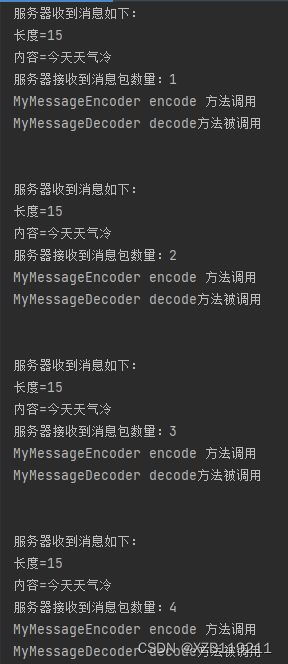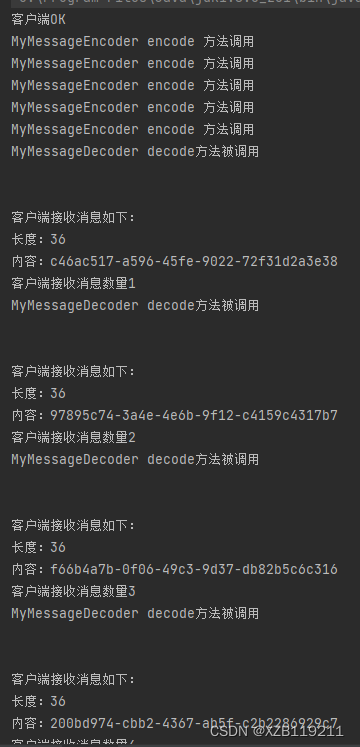TCP粘包和拆包
(1)TCP是面向连接的,面向流的,提供可靠性服务。收发两端(客户端和服务端)都要有一一成对的socket,因此,发送端为了将多个发给接收端的包,更有效的发给对方,使用了优化方法(Nagle算法),将多次间隔较小且数据量小的数据,合并成一个大的数据块,然后进行封包。这样做虽然提高了效率,但是接收端难于分辨出完整的数据包,因为面向流的通信是无消息保护边界的。
(2)由于TCP无消息保护边界,需要在接收端处理消息边界问题,也就是我们所说的粘包和拆包问题。
(3)TCP粘包、拆包图解
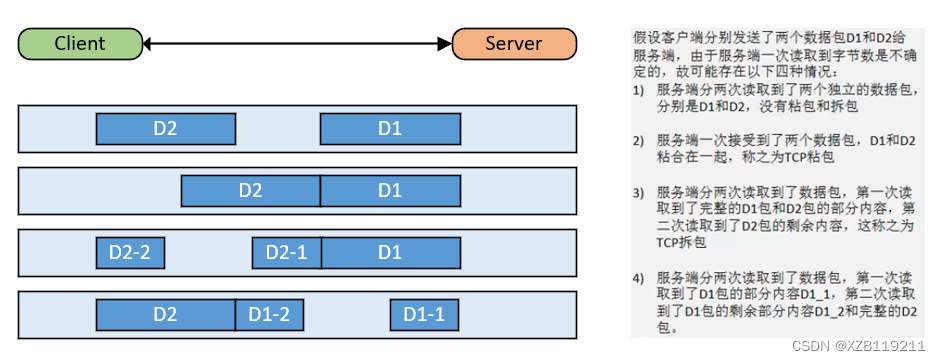
下面我们通过Netty实验还原场景:
我们通过这样的方法来还原粘包和拆包场景,客户端循环想服务端发送10条消息,服务端每次接收到消息即想客户端返回一个UUID,我们可以通过观察,这10条消息服务端接收过程中并不是一次性接收的,并且每次发送接收结果不一,说明部分消息发生了粘包现象(拆包现象)
服务端:
MyServer
package com.sgg.Netty.TCP;
import com.sgg.Netty.simple.NettyServerhandler;
import io.netty.bootstrap.ServerBootstrap;
import io.netty.channel.*;
import io.netty.channel.nio.NioEventLoopGroup;
import io.netty.channel.socket.SocketChannel;
import io.netty.channel.socket.nio.NioServerSocketChannel;
public class MyServer {
public static void main(String[] args) throws InterruptedException {
//创建BossGroup和WorkerGroup
//说明
//1、创建两个线程组BossGroup和WorkerGroup
//2、BossGroup只负责处理请求,真正和客户端的业务处理会交给WorkerGroup
//3、两个都是无限循环
EventLoopGroup bossGroup = new NioEventLoopGroup(1);
EventLoopGroup workerGroup = new NioEventLoopGroup();
//创建服务端的启动对象,配置启动参数
ServerBootstrap bootstrap = new ServerBootstrap();
//使用链式变成来进行设置
bootstrap.group(bossGroup,workerGroup) //设置两个线程组
.channel(NioServerSocketChannel.class) //使用NioServerSocketChannel作为服务器的通道实现
.option(ChannelOption.SO_BACKLOG,128) //设置线程队列的连接个数
.childOption(ChannelOption.SO_KEEPALIVE,true) //设置保持活动连接状态
.childHandler(new MyServerInitializer());
System.out.println(".....服务器准备好了");
// Future-Listener机制
//绑定一个端口并且同步,生成一个ChannelFuture对象
ChannelFuture cf = bootstrap.bind(6668).sync();
//给cf注册监听器,监控我们关心的事件
cf.addListener(new ChannelFutureListener() {
@Override
public void operationComplete(ChannelFuture channelFuture) throws Exception {
if(cf.isSuccess()){
System.out.println("监听端口成功");
}else{
System.out.println("监听端口失败");
}
}
});
//对关闭通道进行监听
cf.channel().closeFuture().sync();
}
}
MyServerInitializer
package com.sgg.Netty.TCP;
import io.netty.channel.ChannelInitializer;
import io.netty.channel.ChannelPipeline;
import io.netty.channel.socket.SocketChannel;
public class MyServerInitializer extends ChannelInitializer<SocketChannel> {
@Override
protected void initChannel(SocketChannel socketChannel) throws Exception {
ChannelPipeline pipeline = socketChannel.pipeline();
pipeline.addLast(new MyServerhandler());
}
}
MyServerhandler
package com.sgg.Netty.TCP;
import io.netty.buffer.ByteBuf;
import io.netty.buffer.Unpooled;
import io.netty.channel.ChannelHandlerContext;
import io.netty.channel.SimpleChannelInboundHandler;
import java.nio.charset.Charset;
import java.util.UUID;
public class MyServerhandler extends SimpleChannelInboundHandler<ByteBuf> {
private int count;
@Override
protected void channelRead0(ChannelHandlerContext channelHandlerContext, ByteBuf byteBuf) throws Exception {
//
byte[] buffer = new byte[byteBuf.readableBytes()];
byteBuf.readBytes(buffer);
//将buffer转成字符串
String message = new String(buffer, Charset.forName("utf-8"));
System.out.println("服务器接收到数据"+ message);
System.out.println("服务器端接收到消息="+ (++this.count));
//服务端回送数据给客户端,回送 一个随机的ID
ByteBuf responseByteBuf = Unpooled.copiedBuffer(UUID.randomUUID().toString()+" ",Charset.forName("utf-8"));
channelHandlerContext.writeAndFlush(responseByteBuf);
}
@Override
public void exceptionCaught(ChannelHandlerContext ctx, Throwable cause) throws Exception {
cause.printStackTrace();
ctx.close();
}
}
MyClient
package com.sgg.Netty.TCP;
import com.sgg.Netty.http.TestServerInitializer;
import com.sgg.Netty.simple.NettyClienthandler;
import io.netty.bootstrap.Bootstrap;
import io.netty.channel.ChannelFuture;
import io.netty.channel.ChannelInitializer;
import io.netty.channel.nio.NioEventLoopGroup;
import io.netty.channel.socket.SocketChannel;
import io.netty.channel.socket.nio.NioSocketChannel;
public class MyClient {
public static void main(String[] args) throws InterruptedException {
//客户端需要一个事件循环组
NioEventLoopGroup eventLoopGroup = new NioEventLoopGroup();
try {
//创建客户端启动对象
//注意客户端不是ServerBootstrap,是Bootstrap
Bootstrap bootstrap = new Bootstrap();
//设置相关参数
bootstrap.group(eventLoopGroup)
.channel(NioSocketChannel.class)
.handler(new MyClientInitializer());
System.out.println("客户端OK");
//启动客户端
ChannelFuture channelFuture = bootstrap.connect("127.0.0.1", 6668).sync();
//给关闭通道进行监听
channelFuture.channel().closeFuture().sync();
} finally {
//关闭
eventLoopGroup.shutdownGracefully();
}
}
}
MyClientInitializer
package com.sgg.Netty.TCP;
import io.netty.channel.ChannelInitializer;
import io.netty.channel.ChannelPipeline;
import io.netty.channel.socket.SocketChannel;
public class MyClientInitializer extends ChannelInitializer<SocketChannel> {
@Override
protected void initChannel(SocketChannel socketChannel) throws Exception {
ChannelPipeline pipeline = socketChannel.pipeline();
pipeline.addLast(new MyClienthandler());
}
}
MyClienthandler
package com.sgg.Netty.TCP;
import io.netty.buffer.ByteBuf;
import io.netty.buffer.Unpooled;
import io.netty.channel.ChannelHandlerContext;
import io.netty.channel.SimpleChannelInboundHandler;
import java.nio.charset.Charset;
public class MyClienthandler extends SimpleChannelInboundHandler<ByteBuf> {
private int count;
@Override
protected void channelRead0(ChannelHandlerContext channelHandlerContext, ByteBuf byteBuf) throws Exception {
byte[] buffer = new byte[byteBuf.readableBytes()];
byteBuf.readBytes(buffer);
String message = new String(buffer,Charset.forName("utf-8"));
System.out.println("客户端接收到消息="+message);
System.out.println("客户端接收消息数量="+(++this.count));
}
@Override
public void channelActive(ChannelHandlerContext ctx) throws Exception {
//使用客户端发送10条数据
for(int i=0;i<10;i++){
ByteBuf buffer = Unpooled.copiedBuffer("hello,server"+i, Charset.forName("utf-8"));
ctx.writeAndFlush(buffer);
}
}
@Override
public void exceptionCaught(ChannelHandlerContext ctx, Throwable cause) throws Exception {
cause.printStackTrace();
ctx.close();
}
}
最终我们可以看到:
服务端入下,同样客户端返回的随机数个数与接收次数统一
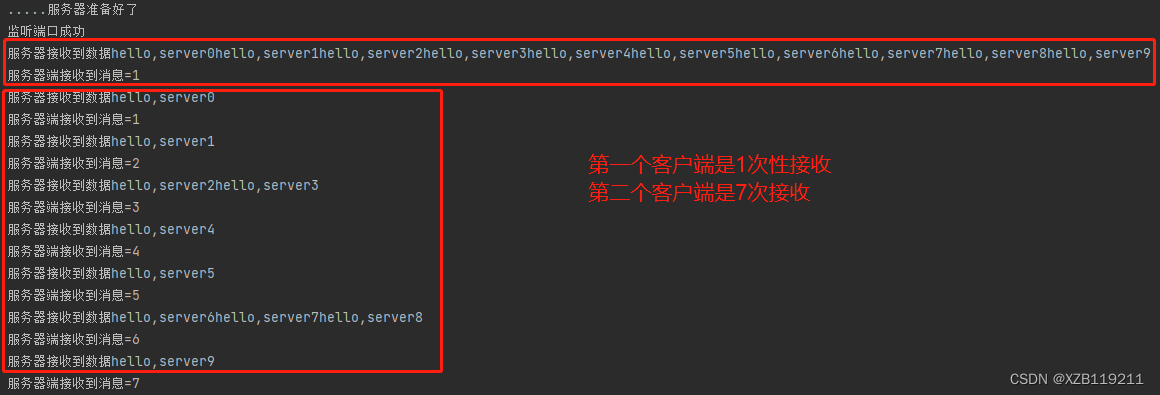 那么我们怎么解决TCP的粘包和拆包呢??
那么我们怎么解决TCP的粘包和拆包呢??
TCP粘包和拆包解决方案
(1)使用自定义协议+编解码器 来解决
(2)关键就是要解决 服务器每次读取数据长度的问题,这个问题解决,就不会出现服务器多读或少读数据的问题,从而避免TCP粘包和拆包
具体实例:
(1)要求客户端发送5个Message对象,客户端每次发送一个Message对象
(2)服务端每次接收一个Message,分5次进行解码,每读到一个Message,会回复一个Message对象给客户端。
下面我们来讲解一下我们的思路:
(1)首先我们需要定义一个协议包的对象,也就是定义协议传输的格式
(2)我们需要根据这个协议包的格式来编写编码解码器的handler:MyMessageEncoder、MyMessageDecoder
(3)我们编写具体的消息发送和消息响应的自定义handler
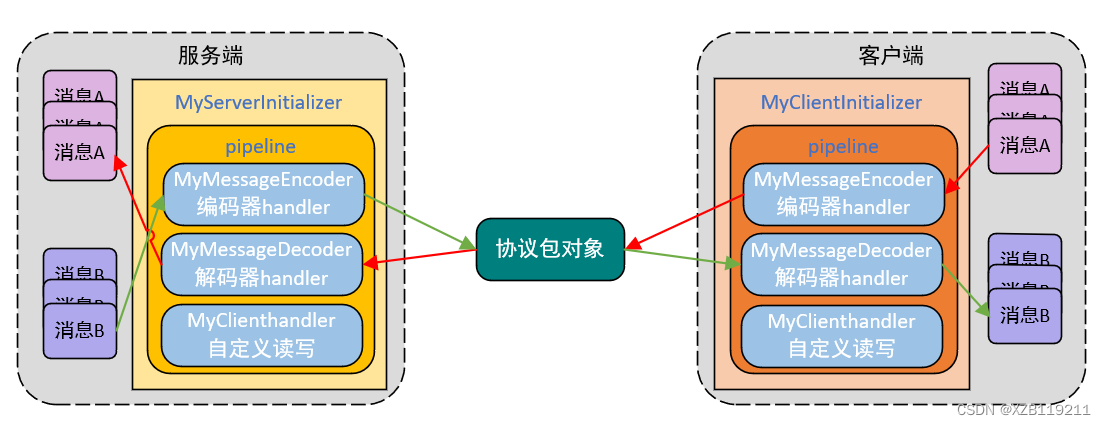
下面我们来看具体实现:
MessageProtocal (协议包类)
package com.sgg.Netty.protocolTCP;
//协议包
public class MessageProtocal {
private int len;// 关键
private byte[] content;
public int getLen() {
return len;
}
public void setLen(int len) {
this.len = len;
}
public byte[] getContent() {
return content;
}
public void setContent(byte[] content) {
this.content = content;
}
}
MyMessageEncoder (编码器类:将消息转换成协议包对象)
package com.sgg.Netty.protocolTCP;
import io.netty.buffer.ByteBuf;
import io.netty.channel.ChannelHandlerContext;
import io.netty.handler.codec.MessageToByteEncoder;
public class MyMessageEncoder extends MessageToByteEncoder<MessageProtocal> {
@Override
protected void encode(ChannelHandlerContext channelHandlerContext, MessageProtocal messageProtocal, ByteBuf byteBuf) throws Exception {
System.out.println("MyMessageEncoder encode 方法调用");
byteBuf.writeInt(messageProtocal.getLen());
byteBuf.writeBytes(messageProtocal.getContent());
}
}
MyMessageDecoder (解码器类:将协议包对象解码为消息)
package com.sgg.Netty.protocolTCP;
import io.netty.buffer.ByteBuf;
import io.netty.channel.ChannelHandlerContext;
import io.netty.handler.codec.ReplayingDecoder;
import java.util.List;
public class MyMessageDecoder extends ReplayingDecoder<Void> {
@Override
protected void decode(ChannelHandlerContext channelHandlerContext, ByteBuf byteBuf, List<Object> list) throws Exception {
System.out.println("MyMessageDecoder decode方法被调用");
//获取length、content
int length= byteBuf.readInt();
byte[] content = new byte[length];
byteBuf.readBytes(content);
//封装成MessageProtlcol对象,放入byteBuf,传递到下一个handler
MessageProtocal messageProtocal = new MessageProtocal();
messageProtocal.setLen(length);
messageProtocal.setContent(content);
//将封装的messageProtocal对象放入list
list.add(messageProtocal);
}
}
服务端类:MyServer、MyServerInitializer、MyServerhandler
MyServer
package com.sgg.Netty.protocolTCP;
import io.netty.bootstrap.ServerBootstrap;
import io.netty.channel.ChannelFuture;
import io.netty.channel.ChannelFutureListener;
import io.netty.channel.ChannelOption;
import io.netty.channel.EventLoopGroup;
import io.netty.channel.nio.NioEventLoopGroup;
import io.netty.channel.socket.nio.NioServerSocketChannel;
public class MyServer {
public static void main(String[] args) throws InterruptedException {
//创建BossGroup和WorkerGroup
//说明
//1、创建两个线程组BossGroup和WorkerGroup
//2、BossGroup只负责处理请求,真正和客户端的业务处理会交给WorkerGroup
//3、两个都是无限循环
EventLoopGroup bossGroup = new NioEventLoopGroup(1);
EventLoopGroup workerGroup = new NioEventLoopGroup();
//创建服务端的启动对象,配置启动参数
ServerBootstrap bootstrap = new ServerBootstrap();
//使用链式变成来进行设置
bootstrap.group(bossGroup,workerGroup) //设置两个线程组
.channel(NioServerSocketChannel.class) //使用NioServerSocketChannel作为服务器的通道实现
.option(ChannelOption.SO_BACKLOG,128) //设置线程队列的连接个数
.childOption(ChannelOption.SO_KEEPALIVE,true) //设置保持活动连接状态
.childHandler(new MyServerInitializer());
System.out.println(".....服务器准备好了");
// Future-Listener机制
//绑定一个端口并且同步,生成一个ChannelFuture对象
ChannelFuture cf = bootstrap.bind(6668).sync();
//给cf注册监听器,监控我们关心的事件
cf.addListener(new ChannelFutureListener() {
@Override
public void operationComplete(ChannelFuture channelFuture) throws Exception {
if(cf.isSuccess()){
System.out.println("监听端口成功");
}else{
System.out.println("监听端口失败");
}
}
});
//对关闭通道进行监听
cf.channel().closeFuture().sync();
}
}
MyServerInitializer
package com.sgg.Netty.protocolTCP;
import io.netty.channel.ChannelInitializer;
import io.netty.channel.ChannelPipeline;
import io.netty.channel.socket.SocketChannel;
public class MyServerInitializer extends ChannelInitializer<SocketChannel> {
@Override
protected void initChannel(SocketChannel socketChannel) throws Exception {
ChannelPipeline pipeline = socketChannel.pipeline();
pipeline.addLast(new MyMessageDecoder()); //添加加码器handler到pipeline
pipeline.addLast(new MyMessageEncoder()); //添加解码器handler到pipeline
pipeline.addLast(new MyServerhandler());
}
}
MyServerhandler
package com.sgg.Netty.protocolTCP;
import io.netty.buffer.ByteBuf;
import io.netty.buffer.Unpooled;
import io.netty.channel.ChannelHandlerContext;
import io.netty.channel.SimpleChannelInboundHandler;
import java.nio.charset.Charset;
import java.util.UUID;
public class MyServerhandler extends SimpleChannelInboundHandler<MessageProtocal> {
private int count;
@Override
public void exceptionCaught(ChannelHandlerContext ctx, Throwable cause) throws Exception {
cause.printStackTrace();
ctx.close();
}
@Override
protected void channelRead0(ChannelHandlerContext channelHandlerContext, MessageProtocal messageProtocal) throws Exception {
//接收到数据,并处理
int len = messageProtocal.getLen();
byte[] content = messageProtocal.getContent();
System.out.println();
System.out.println();
System.out.println("服务器收到消息如下:");
System.out.println("长度="+len);
System.out.println("内容="+new String(content,Charset.forName("utf-8")));
System.out.println("服务器接收到消息包数量:"+(++this.count));
//回复消息
//定义一个字符串
String responseContent = UUID.randomUUID().toString();
//将字符串转为byte数组
byte[] rescontent = responseContent.getBytes("utf-8");
//得到数据长度
int reslength = responseContent.getBytes("utf-8").length;
//封装成messageProtocal1对象
MessageProtocal messageProtocal1 = new MessageProtocal();
messageProtocal1.setLen(reslength);
messageProtocal1.setContent(rescontent);
channelHandlerContext.writeAndFlush(messageProtocal1);
}
}
客户端类:MyClient、MyClientInitializer、MyClienthandler
MyClient
package com.sgg.Netty.protocolTCP;
import io.netty.bootstrap.Bootstrap;
import io.netty.channel.ChannelFuture;
import io.netty.channel.nio.NioEventLoopGroup;
import io.netty.channel.socket.nio.NioSocketChannel;
public class MyClient {
public static void main(String[] args) throws InterruptedException {
//客户端需要一个事件循环组
NioEventLoopGroup eventLoopGroup = new NioEventLoopGroup();
try {
//创建客户端启动对象
//注意客户端不是ServerBootstrap,是Bootstrap
Bootstrap bootstrap = new Bootstrap();
//设置相关参数
bootstrap.group(eventLoopGroup)
.channel(NioSocketChannel.class)
.handler(new MyClientInitializer());
System.out.println("客户端OK");
//启动客户端
ChannelFuture channelFuture = bootstrap.connect("127.0.0.1", 6668).sync();
//给关闭通道进行监听
channelFuture.channel().closeFuture().sync();
} finally {
//关闭
eventLoopGroup.shutdownGracefully();
}
}
}
MyClientInitializer
package com.sgg.Netty.protocolTCP;
import io.netty.channel.ChannelInitializer;
import io.netty.channel.ChannelPipeline;
import io.netty.channel.socket.SocketChannel;
public class MyClientInitializer extends ChannelInitializer<SocketChannel> {
@Override
protected void initChannel(SocketChannel socketChannel) throws Exception {
ChannelPipeline pipeline = socketChannel.pipeline();
pipeline.addLast(new MyMessageEncoder());
pipeline.addLast(new MyMessageDecoder());
pipeline.addLast(new MyClienthandler());
}
}
MyClienthandler
package com.sgg.Netty.protocolTCP;
import io.netty.buffer.ByteBuf;
import io.netty.buffer.Unpooled;
import io.netty.channel.ChannelHandlerContext;
import io.netty.channel.SimpleChannelInboundHandler;
import java.nio.charset.Charset;
import java.nio.charset.StandardCharsets;
public class MyClienthandler extends SimpleChannelInboundHandler<MessageProtocal> {
private int count;
@Override
protected void channelRead0(ChannelHandlerContext channelHandlerContext, MessageProtocal messageProtocal) throws Exception {
int len = messageProtocal.getLen();
byte[] content = messageProtocal.getContent();
System.out.println();
System.out.println();
System.out.println("客户端接收消息如下:");
System.out.println("长度:"+len);
System.out.println("内容:"+new String(content,Charset.forName("utf-8")));
System.out.println("客户端接收消息数量"+(++this.count));
}
@Override
public void channelActive(ChannelHandlerContext ctx) throws Exception {
//使用客户端发送10条数据
for(int i=0;i<5;i++){
String mes = "今天天气冷";
byte[] content = mes.getBytes(Charset.forName("utf-8"));
int length = mes.getBytes(Charset.forName("utf-8")).length;
//创建协议包对象
MessageProtocal messageProtocal = new MessageProtocal();
messageProtocal.setLen(length);
messageProtocal.setContent(content);
ctx.writeAndFlush(messageProtocal);
}
}
@Override
public void exceptionCaught(ChannelHandlerContext ctx, Throwable cause) throws Exception {
System.out.println("异常信息="+cause.getMessage());
ctx.close();
}
}
如上我们可以得到结果如下,不论怎么发送,消息永远不会发生粘包和拆包的现象:
